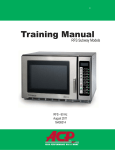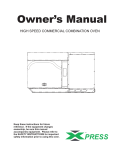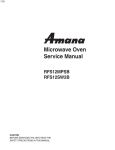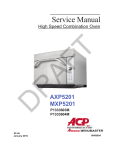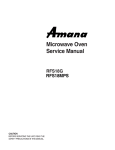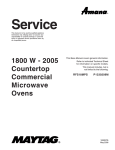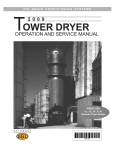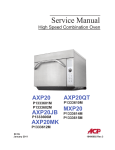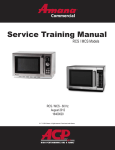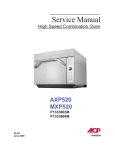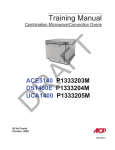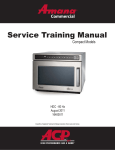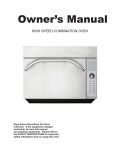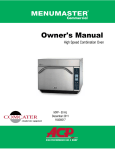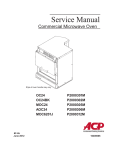Download Maytag RFS12MPS Service manual
Transcript
R Commercial Service Training Manual RFS Models RFS - 60 Hz August 2011 16400013 Amana® is a Registered Trademark of Maytag Corporation. Brand used under license. 1 2011 RFS Training Manual.indd 1 10/3/2011 8:36:35 AM Table of Contents Important Safety Information........................................................................................1-5 Quick Start Reference Guide......................................................................................9-11 !"# $%&%'($%)*% '($%)*%+ '%*!,(#+ ,/0%((%2 2011 RFS Training Manual.indd 2 10/3/2011 8:36:35 AM 1 Important Safety Information 1 2011 RFS Training Manual.indd 1 10/3/2011 8:36:35 AM Important Information Important Notices for Servicers and Consumers ACP will not be responsible for personal injury or property damage from improper service procedures. Pride and workmanship go into every product to provide our customers with quality products. It is possible, however, that during its lifetime a product may require service. Products should be serviced only by a qualified service technician who is familiar with the safety procedures required in the repair and who is equipped with the proper tools, parts, testing instruments and the appropriate service information. IT IS THE TECHNICIANS RESPONSIBLITY TO REVIEW ALL APPROPRIATE SERVICE INFORMATION BEFORE BEGINNING REPAIRS. ! WARNING To avoid risk of severe personal injury or death, disconnect power before working/servicing on appliance to avoid electrical shock. To locate an authorized servicer please contact: ComServ Support Center Web Site WWW.ACPSOLUTIONS.COM ....................... Telephone Number 1-866-426-2621 or 319-368-8195 E-Mail: [email protected] Recognize Safety Symbols, Words, and Labels ! DANGER DANGER— Immediate hazards which WILL result in severe personal injury or death. ! WARNING WARNING— Hazards or unsafe practices which COULD result in severe personal injury or death. ! CAUTION CAUTION— Hazards or unsafe practices which COULD result in minor personal injury, product or property damage. 2 2011 RFS Training Manual.indd 2 10/3/2011 8:36:36 AM Important Safety Information ! WARNING Read the following information to avoid possible exposure to microwave radiation: The basic design of the Microwave Oven makes it an inherently safe device to both use and service. However, there are some precautions which should be followed when servicing the microwave to maintain this safety. These are as follows: 1. Always operate the unit from an adequately grounded outlet. Do not operate on a two-wire extension cord. 8. Do not for any reason defeat the interlock switches there is not valid reason for this action at any time; nor will it be condoned by ACP. 2. Before servicing the unit (if unit is operable) perform the microwave leakage test. 9. IMPORTANT: Before returning a unit to a customer, be sure to check for proper switch interlock action. 3. The oven should never be operated if the door does not fit properly against the seal, the hinges or hinge bearings are damaged or broken; the choke is damaged, (pieces missing, etc.); or any other visible damage can be noted. Check the choke area to ensure that this area is clean and free of all foreign matter. 10. The Microwave Oven should never be operated with any components removed and/or bypassed or when any of the safety interlocks are found to be defective, or when any of the seal surfaces are defective, missing, or damaged. 11. All microwave ovens meet all requirements of the radiation control for Health and Safety Act of 1968. Due to measurement uncertainties, the maximum leakage for the field will be 4mw/cm2. 4. If the oven operates with the door open and produces microwave energy, take the following steps: A. Tell the user not to operate the oven. B. Contact ACP ComServ immediately. 12. To ensure that the unit does not emit excessive microwave leakage and to meet the Department of Health and Human Services guidelines, check the oven for microwave leakage using a microwave oven leakage meter that complies with US Government CDRH / FDA / DHHS requirements and or any other local government requirements. The maximum leakage level allowed by ACP 2 is 4mw/cm . 5. Always have the oven disconnected when the outer case is removed except when making the "live" tests called for in the Service Manual. Do not reach into the equipment area while the unit is energized. Make all connections for the test and check them for tightness before plugging the cord into the outlet. 6. Always ground the capacitors on the magnetron filter box with an insulated-handle screwdriver before working in the high voltage area of the equipment compartment. Some types of failures will leave a charge in these capacitors and the discharge could cause a reflex action which could make you injure yourself. 13. If servicer encounters an emission reading over 4mw/cm 2, the servicer is to cease repair and contact the ACP ComServ Department immediately for further direction. ACP will contact the proper Government Agency upon verification of the test results. 7. Always remember that in the area of the transformer there is HIGH VOLTAGE. When the unit is operating keep this area clear and free of anything which could possibly cause an arc or ground, etc. 3 2011 RFS Training Manual.indd 3 10/3/2011 8:36:36 AM IMPORTANT SAFETY INSTRUCTIONS Recognize this symbol as a SAFETY message ! WARNING 0,*(%=* U!&" %*,*)!&4)%)*,%7&!*%U %,7U%U%8*%" %*)(,&4( >?%*!&%*(=* + D@D',!!"!3 >??@DEED0, F$>?H'D@'D?JD$DKE> >L$DH>'D>L>J>MD0?J> >@>NOP, ( K!"&)8%,! 4,,)) %%)%,7!&%* U %)%3)!*% ',=* MH'K>NDH@> " % %"NDH@>*F NDH@@N/>?'@N@'H'D@P (2 # %,=* D@EO %)4,,%* ,* 2 %)**,4,(()) %T&%6 U)(8%T% !6 ))DHE@D'!>?'> ,3 H,=* D@EO&%))* )%!),**%%3 ,%3 %,=* '," &3 ")(),U7U %)%"&))()&%)*%% !%%"* ?4,"=* UED>H$>JD@ %"4,*)!"E>@ D@D' %,=* &, )()%)% *(U&4%7( % %"U %&,!)()%)% ) ',=* U*)( 4%%)U*! %3)D@EO!"=*)%3 % %%=*%)%3=* %*,%)%3&"&% 6U% %U%)8* D@D'3%%!7*3%%,% ( =* # D@D'%,=* *)%D@D' *, %)*%4%V&%6 U% 7,7U4!U4( U %% 2 D@D'%%)% *(4% W %)?0?O&%>?'>*%& D@D'%),(3%)(&!% counter. %%*" )%(%* (?#& ,4%* PRECAUTIONS TO AVOID POSSIBLE EXPOSURE TO EXCESSIVE MICROWAVE ENERGY A. DO NOT %,34,,)% )% %%*,%&* 6 *%%43%(" %)&% %4,,&"%7 B. DO NOT "!8!4,3&%&),)%4%%%)* **(*%& C. DO NOT %,3&)() %*%" %,,3)% % %") ,,%)(,: )%;!< ,(),;!%7%)< )%)(*%& ',3,*)!)8*)%% %)!""6 % %"=*)%3 % SAVE THESE INSTRUCTIONS 4 2011 RFS Training Manual.indd 4 10/3/2011 8:36:37 AM IMPORTANT SAFETY INSTRUCTIONS WARNING WARNING '3)%7&%,33": E=*)*,4%U&&U%%! !3%,)!"),!( 4,* %(!!()**%&&, =*)J!!*!!(%!(4,,% %3)&%,%4334" %'DHE>HE'@J>OD' EXHH>@EOKDE@NDJ>0>@? $DD@DD'>H'>@E@>'>@'D '>EXH'%)*,%7&8*%" %: D@D'3%7&)%&*")3 4, %U U%,%!*! %% )),3& 7( ! 34%4&% %% !(!&% (!(3 c. I&%),3(U7 3 )%ED>U*%3&&)) , 4%%)U%,*&& 4%,&*% %*!%7% < 3%,,=*) < %,=*)!,!&%),&4",%*(, ,( < *%(,))%4,%%4 7 3< ?&%,(U4,%), %433&%,%!&%%3( ,% 3< H6%%4,%( % ,%*,% ) D@D'*,3"&%%(D@D' 3 % %)*U7(*U%&) ,3"4,* ! CAUTION '3) %8*%"% % %")(U!%3,&4(: ) &&%"3*)3%, )!,%)*,) + @3%* %U U%,%!*! %,%))&%7( 7%%,((,%4, *!%7"7*(%43%(" $%*%"!*)* )%* $%"7 4,&%7%7&!&%7( 0,7(4, %U U%,% !*!%U&4*&*%%Y %) %)** * %44,,"% ,%",!%)",*) )* %( $%7& UU)% &)!&%7(4,%43%(" 0,7 %)U 3" ,)%% !( 3)%=*)*)6 )=*7") *%%!(!%7$%% %%!(!&%,( # %=* 4,*)%&) 33" 5. M%43 %,*)! ) 3 '3) 7%&*U* ,"% 7%*&*%%!* &&&%43%(" 7% *%(*%7(,%% 3M7(,%% %*%")"*%%U &*U%)(3 # ?*,%)%3%MH' =* *"%) )% %&% &**%* **3 ***&3 SAVE THESE INSTRUCTIONS 5 2011 RFS Training Manual.indd 5 10/3/2011 8:36:38 AM 2 RFS 60 Hz Specifications Installation · Unpacking the oven · Radio Interference · Oven Placement Power Specification · Input- Power Source · Output- Power Source · Power Consumption Cavity Dimensions · Weight 6 2011 RFS Training Manual.indd 6 10/3/2011 8:36:38 AM Installation Unpacking Oven Oven Placement Z 3&%)(*,))%% ))33" Z %")%!%7(*%& *%, )" *3&)() Z 3%&%3%% Z &3,!%)6%")%U4 &4,*%!&%( 4% Z 36%!3*%&,U *, 3%) &&%"%',*)* %433 % % %")*) ,%&&% % Z !7%!%*3%?4&% ( Z 33*% *%& Radio Interference M%43 %"*%&%%)U 3U%%3)*% %&%!")(,&4(: Z )%)(*%&&3%)( %*F%)(P Z $%)U3U&% ! &%3 Z H % %")%)U3U !%(%(% A A A B A—?4[,/%& %%*) ))&=* $% %%\4%*)=* % 0,%%)%\4U3" % % %")&&% % reduced. Oven Clearances 7 2011 RFS Training Manual.indd 7 10/3/2011 8:36:38 AM Models Power Source J(? ? %( %=*" ($,U4%(%*)) $*((*%/%) Power Output @%43%(" ;>2< M* %*%% D %(%=*" Power Consumption 7)M%43 Dimensions Cabinet 0), (, , Cavity Dimensions 0), (, , Weight Crated Uncrated RFS12MPSB, RFS12SW2B, RFS12SW2C, RFS12TS(W) RFS18MPS, RFS18TS J ? 60 Hz X @>M?2 #J ? 60 Hz X @>M? 0 0 b/2b #2M b/b #2M 0U 0 gP;22< #hP;< hP;2#< gP;22< #hP;< hP;2#< #hP;< +P;< /P;#< #hP;< +P;< /P;#< !;7(< #!;+7(< !;7(< !;7(< 8 2011 RFS Training Manual.indd 8 10/3/2011 8:36:38 AM 3 RFS 60 Hz Quick Start Reference Guide Control Panel · Manual operation · Programming items · Qty 2X Pad Clean Filter User Options · Changing options · Factory presets 9 2011 RFS Training Manual.indd 9 10/3/2011 8:36:39 AM Quick Start Reference Guide Refer to Product Safety Manual for Safety Statements CLEAN FILTER CLEAN FILTER Complete Owner’s Manual available online This oven displays at user ))%30,,( displays ACP recommends cleaning the %%,%*(,y. Cleaning the air The message will stop displaying automatically after 24 hours. Depending on microwave use and environmental )U,%")! cleaned more frequently. Once the frequency is determined, set the option for the appropriate time frame. Oven Wall Clearances A—For North American (UL/CSA) models, allow at least 2” (5.1 cm) of clearance around top of oven. For International (50 Hz) models, allow at least 12” (30 cm) of clearance around top of oven. Proper air \4%*)3% 0, %%)%\w, oven may not operate properly and life of electrical parts is reduced. B—Allow at least 2” (5.1 cm) between air discharge on back of oven and back wall. C—Allow at least 2” (5.1 cm) of clearance around sides of oven. So...how do I use it? Preprogrammed Pads To cook food using preprogrammed cooking =*: 1. Open oven door and place food in oven. Close door. 2. Press desired pad. 3. Oven begins to cook. 4. At end of cooking cycle oven beeps and shuts off. QTY 2X Programming (some models) T,(,7(&%: 1. Open oven door. 2. Press and hold pad 1 for approximately 5 seconds. 3. Press pad to be reprogrammed. 4. Press the QTY 2X pad. 5. Press a numbered pad to change the cooking factor. Z Cooking factor can be set from 10% to 100%. Z Default is 80%. Z Pad 5 would change the cooking factor to 50%. 6. Press START pad to save changes. (Electronic Control) Manual Operation T7&)*( %)) 4%3: 1. Open oven door and place food in oven. Close door. 2. Press TIME ENTRY pad and enter cooking time. 3. Press a power level pad to change power level if desired (some models). Z COOK LEVEL displays with the power setting. 4. If stage cooking is desired, press TIME ENTRY pad and repeat steps 2 through 4, (some models). 5. Press START pad. 6. At end of cooking cycle oven beeps and shuts off. Programming Items 1. 2. 3. 4. 5. 6. Open oven door. Press and hold pad 1 for approximately 5 seconds. Press pad to be reprogrammed. Enter cooking time by using the number pads. Press a power level pad to change power level if desired. If stage cooking is desired, press TIME ENTRY pad. Z "!%\",4,(*!r. Z Display changes to cook time and power level for the next stage. 7. Enter cook time and power level as in steps 4 and 5 (some models). Z To enter another cooking stage for that pad, press TIME ENTRY pad again. Z Up to four different stages can be programmed (some models). 8. Press START pad to set new programming changes to the pad. NOTE: To discard changes, press STOP/RESET pad or close oven door. QTY 2X Pad 1. 2. 3. 4. (some models) Open oven door and place food in oven. Close door. Press QTY 2X pad. Press desired preprogrammed pad or pad sequence. Oven begins cooking. Displayed cooking time is the total of original cooking time and added 2X time. The switching operation of this microwave oven can cause voltage \*tuations on the supply line. The operation of this oven under unfavorable voltage supply conditions can have adverse effects. This device is intended for the connection to a power supply system with a maximum permissible system impedance Zmax of at the interface point of the user’s supply. The user has to *%,,)3)" 4%* ""4,,&*,%=*%!3&%", the user can ask the public power supply company for the system impedance at the interface point. 10 2011 RFS Training Manual.indd 10 10/3/2011 8:36:39 AM Quick Start Reference Guide Refer to Product Safety Manual for Safety Statements Complete Owner’s Manual available online Can I change an option? Options such as single or double pad programming, beep volume, and maximum cooking time can be changed to suit individual preferences. To change options: 1. Open oven door. Z If door is closed or RESET pad is pressed before programming is complete, changes are discarded and microwave exits programming mode. 2. Press and hold pad 2 for approximately 5 seconds. Z This begins options mode. Z Microwave will beep and 0P: displays. 3. Press number pad that controls option to be changed. Z See table below for options. Z Current option will display. 4. Press number pad again to change the option. Z Each time pad is pressed, option will change. Z Match code displayed with code for desired option. 5. Press START pad to save changes. Z To change additional options, repeat steps 3 and 4. Z Changes appear after door is closed or STOP/RESET pad is pressed. DO NOT power spray No metal pans Numbered Pads 1 End of Cycle Beep Display Options OP:10 3 second beep. OP:11 Continuous beep until door is opened. OP:12 5 beep bursts until door is opened. 2 OP:20 Eliminates beep. Key Beep Volume OP:21 Sets volume to low. OP:22 Sets volume to medium. 3 Key Beep 4 Active Display OP:23 Sets volume to high. OP:30 Prevents beep when pad is pressed. OP:31 Allows beep when pad is pressed. OP:40 15 seconds after oven door is opened, keyboard disabled. OP:41 30 seconds after oven door is opened, keyboard disabled. OP:42 1 minute after oven door is opened, keyboard disabled. OP:43 2 minutes after oven door is opened, keyboard disabled. 5 OP:50 Prevents On-the Fly Cooking OP:51 Allows 6 OP:60 Opening oven door does not reset oven back to ready mode. Reset to Ready Mode 7 (some models) . . OP:61 Opening oven door resets oven back to ready mode. OP:70 Allows 60 minutes of heating time (some models). OP:71 Allows 10 minutes of heating time. OP:80 Allows use of preprogrammed pads only. Maximum Heating Time 8 Manual Operation 9 (some models) OP:81 Allows use of manual time entry and preprogrammed pads. OP:90 Allows 10 (0-9) preprogrammed pads. OP:91 Allows 100 (00-99) preprogrammed pads. Double Digit Operation 0 Clean Filter Message OP:00 Do not display message. OP:01 Display message for 24 hours every 7 days. OP:02 Display message for 24 hours every 30 days. OP:03 Display message for 24 hours every 90 days. Part No.12804405 11 2011 RFS Training Manual.indd 11 10/3/2011 8:36:40 AM 4 RFS 60 Hz Components Location 12 2011 RFS Training Manual.indd 12 10/3/2011 8:36:40 AM Components Location Cavity TCO Top Stirrer Motor Blower Motor H.V. Capacitor H.V. Capacitor Top Antenna Diode Diode Transformer Magnetron TCO’s Fuse Magnetrons Board Oven Door Interlock Switch Control Panel Splatter Shield Transformer Bottom Antenna Oven Tray Bottom Stirrer Motor Suction Cup (Used for aid in removing oven tray) 59001235 13 2011 RFS Training Manual.indd 13 10/3/2011 8:36:41 AM 5 Disassembly Door removal · Disassembly Control panel removal · Wire terminals 14 2011 RFS Training Manual.indd 14 10/3/2011 8:36:41 AM Disassembly Door Removal 1. Disconnect power to oven. 2. Open oven door, remove top hinge cap, and slowly lift door to disengage the hinge pins at top and bottom. Top hinge cap Top hinge cap 3. To reinstall door, place top pin into slot first, then align bottom pin. 4. Reinstall top hinge cap. Choke cover Outer Door panel Latch assembly * Door Handle Spring Door frame/ choke assembly * Apply thread lock compound to threads, tighten side screw first. 15 2011 RFS Training Manual.indd 15 10/3/2011 8:36:42 AM Disassembly Control Panel Removal 1. 2. 3. 4. Disconnect power to oven and remove outer case. Disconnect and label wires from controller/timer. Open oven door. Remove screw securing top of control panel to cavity. Lift control panel up and out to release tabs. Disconnecting Wire Terminals All wire terminals are locking-type terminals. Proceed as follows to disconnect wire terminals: Insulated terminals: Grasp insulator pod and pull back. DO NOT PULL ON WIRE. 1 Grasp Wire 2 Pull Insulator Pod Non-insulated terminals: Use a small blade screwdriver to depress locking-tab and pull on terminal. DO NOT PULL ON WIRE. 1 Release locking-tab Wire 2 Pull 16 2011 RFS Training Manual.indd 16 10/3/2011 8:36:43 AM 6 Performance Testing Procedures 17 2011 RFS Training Manual.indd 17 10/3/2011 8:36:43 AM Performance Testing Procedures ! WARNING To avoid risk of electrical shock, personal injury or death, disconnect power to oven and discharge capacitor before servicing, unless testing requires it. All Amana and Menumaster microwave oven power outputs are rated using the IEC705 standards. Using the IEC705 test method requires precision measurements and equipment that is not practical to be performed in the field. Using the test shown below will indicate if the oven performance is satisfactory. Test equipment required: x x 1000 ml test container and thermometer. Digital watch / watch with a second hand for use on ovens with electromechanical timers. Important Notes: x x x Low line voltage will cause low temperature rise / power output. Ovens must be on a dedicated circuit, properly grounded, and polarized. Other equipment on the same circuit may cause a low temperature rise / power output. This test and results are not a true IEC705 test procedures and are only intended to provide servicers with an easy means of determining if the microwave oven cooking output is correct. Procedure 1. Fill the test container to the 1000 ml line with cool tap water. NOTE: Water temperature should be approximately 60qF / 16qC 2. Using the thermometer, stir water for five to ten seconds; measure, and record the temperature (T1). 3. Place test container of water in the center of oven cavity and close door. 4. Heat the water for a 33-second full power cycle. NOTE: Use a digital watch or a watch with a second hand for ovens with electromechanical timers. 5. At end of the cycle, remove test container. Using the thermometer, stir water for five to ten seconds and record temperature (T2). 6. Subtract the starting water temperature (T1), from the ending water temperature (T2) to obtain the temperature rise (T). 7. If the temperature rise (T) meets or exceeds the minimum, the test is complete. If the temperature rise (T) fails to meet the minimum temperature rise, test the line voltage to verify it is correct. Then repeat steps 1 - 6 making sure to change the water. If the temperature rise (T) fails to meet the minimum temperature rise again the oven will require service. Minimum Temperature Rise at Thirty -Three (33) Seconds Run Time T (°F) Cooking Power Output 10 ................. 1000 11 ................. 1100 12 ................. 1200 14 ................. 1400 17 ................. 1700 18 ................. 1800 19 ................. 1900 T (°F) Cooking Power Output T (°C) 20 ................. 2000 21 ................. 2100 22 ................. 2200 24 ................. 2400 25 ................. 2500 27 ................. 2700 30 ................. 3000 Cooking Power Output 5 .............. 1000 5.5 ............ 1100 6.5 ............ 1200 7.5 ............ 1400 9.5 ............ 1700 10 ............. 1800 10.5 .......... 1900 T (°C) Cooking Power Output 11............ 2000 11.5......... 2100 12............ 2200 13............ 2400 13.5......... 2500 15............ 2700 16.5......... 3000 18 2011 RFS Training Manual.indd 18 10/3/2011 8:36:44 AM 7 Component Testing Procedures 19 2011 RFS Training Manual.indd 19 10/3/2011 8:36:44 AM Component Testing Procedures ! WARNING To avoid risk of electrical shock, personal injury or death, disconnect power to oven and discharge capacitor before servicing, unless testing requires it. Illustration Component Thermal cutout Testing Disconnect all wires from TCO. Measure resistance across terminals. Cavity TCO ............................................. Magnetron TCO ...................................... Diode Discharge Capacitor Remove diode lead from capacitor and connect ohmmeter. Capacitor Reverse leads for second test. Discharge Capacitor Remove wires from capacitor terminals and connect ohmmeter, set on highest resistance scale to terminals. Magnetron Also check between each terminal and capacitor case. Discharge Capacitor Remove wires from magnetron and connect ohmmeter to terminals. Also check between each terminal and ground. Blower motor Transformer NOTE: Ohmmeter must contain a battery of 6 volts minimum. Between Terminals: Meter should momentarily deflect towards zero then return to over 5 M:. If no deflection occurs, or if continuous deflection occurs, replace capacitor. Terminal to Case: Infinite resistance Between Terminals: Less than 1 : Each terminal to ground measures Infinite resistance. Note: This test is not conclusive. If oven does not heat and all other components test good replace the magnetron and retest. Approximately 28 – 35 : Remove all wires from motor. Measure resistance across terminals ..... Secondary Closed at 32qF (0qC) and Opens at 230qF (110qC) Closed at 140qF (60qC) and Opens at 320qF (160qC) Infinite resistance should be measured in one direction and 50K: or more in the opposite direction. Remove all wires from motor. Measure resistance across coil .............. Stirrer motor Results Approximately 12 – 14 K: Discharge Capacitor Remove all wires from terminals. Filament Measure resistance from: Primary .................................................. Less than <1 : Filament................................................. Less than <1 : Secondary to Ground screw on transformer stack................................... Approximately 90-100 : Primary Noise filter board Power In terminals .................................. Power Out terminals ............................... Power In terminals .................................. Power Out terminals ............................... 120 VAC (RFS12) 120 VAC (RFS12) 240 VAC (RFS18) 240 VAC (RFS18) If no power in, check power outlet. If no power out, check fuses. Circuit Protector Measure resistance across terminals ..... Between Terminals: Less than 1 : 20 2011 RFS Training Manual.indd 20 10/3/2011 8:36:45 AM Component Testing Procedures ! WARNING To avoid risk of electrical shock, personal injury or death, disconnect power to oven and discharge capacitor before servicing, unless testing requires it. Illustration Component Interlock switch assembly Testing Disconnect wires to switch. Results With door open measure resistance from: Top Monitor – COM (PK) – NO (BL) ........ Btm Monitor – COM (WH) – NO (RD) ...... Top Primary – COM (RD BK) – NC (BN) Btm Primary – COM (BK) – NC (BL)........ Secondary – COM (PK) – NC (GN) ........ Indicates continuity Indicates continuity Infinite : Infinite : Infinite : With door closed measure resistance from: Top Monitor – COM (PK) – NO (BL)....... Btm Monitor – COM (WH) – NO (RD) ...... Top Primary – COM (RD BK) – NC (BN) Btm Primary – COM (BK) – NC (BL)........ Secondary – COM (PK) – NC (GN) ........ Infinite : Infinite : Indicates continuity Indicates continuity Indicates continuity After verifying or replacing the module, reconnect wires to switch and check operation of monitor circuit before operating the oven. Lamp receptacle Test continuity of receptacle terminals. Wire Harness Test continuity of wires Service Test Mode: Error codes: Indicates continuity with bulb installed. Indicates continuity Electronic Control Panel SERVICE appears in the display Open door, Press and Hold pad 3 for 5 seconds to enter service test mode. Press Pad 1.................................................. Indicates number of hours magnetron has been turned on Press Pad 2.................................................. Indicates number of times magnetron tube has been turned on and off Press Pad 3.................................................. Indicates number of door cycles Press Pad 4.................................................. CLEAR (Press START pad to reset service data.) Press Pad 5.................................................. Indicates amperage (Top Mag) Press Pad 6.................................................. Indicates amperage (Bottom Mag) Press Pad 7.................................................. Press Pad 8.................................................. Press Pad 9.................................................. Press Pad 0.................................................. Stop/Reset Pad ............................................ E-08.............................................................. E-09.............................................................. E-10.............................................................. RESET (Clear Service Alarm) N/A N/A N/A Exit Service Test Mode Replace Control Board Replace Control Board Shorted or Open Keypad – Test and replace if necessary 21 2011 RFS Training Manual.indd 21 10/3/2011 8:36:46 AM Component Testing Procedures RFS12* ! WARNING To avoid risk of electrical shock, personal injury or death, disconnect power to oven and discharge capacitor before servicing, unless testing requires it. RLY 3 1 2 TAB 1 TAB 2 9 8 5 4 3 1 CN1 Function Power to current transformer Power from current transformer Power from Oven TCO Power to Oven Light Power to Blower Motor Secondary Interlock Switch Power to Relay 3 Test Set-Up / Condition All Conditions Meter Setting Volts Probe Placement Results Tab 1 to CN1 Pin 3 (Neutral) 120 VAC All Conditions Volts Tab 2 to CN1 Pin 3 (Neutral) 120 VAC All Conditions Standby ............. Ready................ Cook.................. Standby ............. Ready................ Cook.................. Door Closed ...... Door Opened .... Volts Volts Volts Volts Volts Volts Volts Ohms Ohms CN1 – Pin 1 (Black wire to Neutral) CN1 – Pin 4 to Pin 1 ............................. CN1 – Pin 4 to Pin 1 ............................. CN1 – Pin 4 to Pin 1 ............................. CN1 – Pin 5 to Pin 1 ............................. CN1 – Pin 5 to Pin 1 ............................. CN1 – Pin 5 to Pin 1 ............................. CN1 – Pin 8 to Pin 9 ............................. CN1 – Pin 8 to Pin 9 ............................. 120 VAC 120 VAC 0 VAC 0 VAC 120 VAC 0 VAC 0 VAC Continuity Infinite Standby ............. Ready................ Cook.................. Volts Volts Volts Relay 3 – Pin 1 to Pin 2 ........................ Relay 3 – Pin 1 to Pin 2 ........................ Relay 3 – Pin 1 to Pin 2 ........................ 120 VAC 120 VAC 0 VAC 22 2011 RFS Training Manual.indd 22 10/3/2011 8:36:46 AM Component Testing Procedures RFS18* ! WARNING To avoid risk of electrical shock, personal injury or death, disconnect power to oven and discharge capacitor before servicing, unless testing requires it. RLY 3 1 2 TAB 1 TAB 2 9 8 5 4 3 1 CN1 Function Power to current transformer Power from current transformer Power from Oven TCO Power to Oven Light Power to Blower Motor Secondary Interlock Switch Power to Relay 3 Test Set-Up / Condition All Conditions Meter Setting Volts Probe Placement Results Tab 1 to CN1 Pin 3 208 / 240 VAC All Conditions Volts Tab 2 to CN1 Pin 3 208 / 240 VAC All Conditions Standby ............. Ready................ Cook.................. Standby ............. Ready................ Cook.................. Door Closed ...... Door Opened .... Volts Volts Volts Volts Volts Volts Volts Ohms Ohms CN1 – Pin 1 (Black wire to ground) CN1 – Pin 4 to Pin 1 ............................. CN1 – Pin 4 to Pin 1 ............................. CN1 – Pin 4 to Pin 1 ............................. CN1 – Pin 5 to Pin 1 ............................. CN1 – Pin 5 to Pin 1 ............................. CN1 – Pin 5 to Pin 1 ............................. CN1 – Pin 8 to Pin 9 ............................. CN1 – Pin 8 to Pin 9 ............................. 208 / 240 VAC 208 / 240 VAC 0 VAC 0 VAC 208 / 240 VAC 0 VAC 0 VAC Continuity Infinite Standby ............. Ready................ Cook.................. Volts Volts Volts Relay 3 – Pin 1 to Pin 2 ........................ Relay 3 – Pin 1 to Pin 2 ........................ Relay 3 – Pin 1 to Pin 2 ........................ 208 / 240 VAC 208 / 240 VAC 0 VAC 23 2011 RFS Training Manual.indd 23 10/3/2011 8:36:47 AM 8 Troubleshooting 24 2011 RFS Training Manual.indd 24 10/3/2011 8:36:47 AM Troubleshooting WHEN YOU GET A COMPLAINT FROM YOUR CUSTOMER, EVALUATE THE COMPLAINT CAREFULLY. IF THE FOLLOWING SYMPTOMS APPLY, PLEASE INSTRUCT THE CUSTOMER IN THE PROPER USE OF THE MICROWAVE OVEN. THIS CAN ELIMINATE AN UNNECESSARY SERVICE CALL. 1. Check grounding before checking for trouble. 2. Be careful of the high voltage circuit. 3. Discharge the high voltage capacitor. 4. When checking the continuity of the switches or of the high voltage transformer, disconnect one lead wire from these parts and then check continuity with the AC plug removed. To do otherwise may result in a false reading or damage to your meter. 5. Do not touch any part of the circuit on the PCB since static electric discharge may damage this control panel. Always touch yourself to ground while working on this panel to discharge any static charge built up in your body. CONDITION Microwave oven does not work. Output power is too low. Sparks occur. Uneven cooking. CAUSE REMEDY Inserting many plugs into one outlet and using them at the same time (blown fuse or breaker) Avoid using other electrical appliances when you use the microwave oven. Microwave oven plug is not inserted tightly. Insert microwave oven plug securely. Low AC input voltage. Use the microwave oven at adequate line voltage. Food temperature is too low. This may not be a defect. It is possible that the food should be cooked for a longer time period. Using metallic ware and allowing it to touch the oven wall. Do not use metallic ware for cooking except that noted in the cooking guide. Ceramic ware trimmed in gold or silver powder is used. Do not use any type of cookware with metallic trimming. Inconsistent intensity of microwave by their characteristics. 1. Use plastic wrap or lid. 2. Stir once or twice while cooking soup, cocoa or milk, etc. Display “CALL SERVICE” See Service Test Mode page 21 to clear CALL SERVICE . 25 2011 RFS Training Manual.indd 25 10/3/2011 8:36:47 AM Troubleshooting Trouble 1: The following visual conditions indicate a probable failed control circuit. 1. Incomplete segments. Z Segment missing. Z Partial segment missing. Z Digit \7%( (Note: Slight \7%( is normal.) 2. )*%%!7 3. A distinct change in the brightness of one or more numbers in display. 4. One or more digits in the display are not lighting. 5. Display indicates a number dif&%&%*,)U&%6 U7"2) %,) y. 6. numbers (for example 7 or 9) will not display when 7" pad is touched. 7. ")*)44,!7(%* 4,7 % 8. Display obviously jumps in time while counting down. 9. "*)4&4,7( 10. >,)%(,)*%&%(7(" 11. Display time of day does not reappear when 7( is ,) CONDITION CHECK 1. No input can be programmed. Check the connection between membrane key assembly and PCB assembly. Continuity. Defective PCB assembly. Replace PCB assembly. No continuity. Loose connection. Connect them tightly. Replace key membrane assembly and check operation. Everything works Defective key membrane assembly. Replace key membrane assembly. Defective PCB assembly. Replace PCB assembly. 2. Some inputs cannot be programmed. 3. Display shows a e num e touched. RESULT Still have trouble. CAUSE REMEDY 4. Random programming when touching other pads. and can not accept any input. 26 2011 RFS Training Manual.indd 26 10/3/2011 8:36:48 AM Troubleshooting Trouble 2: Oven does not operate at all, Display window does not display any (*%U ) * ) CONDITION 1. Fuse blows. CHECK Check continuity of monitor switch (with door closed). RESULT Continuity. CAUSE REMEDY Malfunction of the monitor switch. Replace fuse, interlock assembly Shorted contact at the primary switch. Replace fuse, interlock assembly No continuity. Replace fuse Check continuity of primary switch (with door opened). Continuity. Check continuity of secondary switch (with door opened). Continuity. Disconnect one side of the wire lead connected from transformer to the high voltage capacitor and operate the unit. 2. Fuse does not blow. No continuity. Malfunction of secondary switch. Replace fuse, interlock assembly No continuity. Fuse blows again Defective high voltage transformer. Replace high voltage transformer. Normal. Set is good condition (defective fuse only) Measure to resistance high voltage capacitor (refer to page 20) Normal. Abnormal. Defective high voltage capacitor. Check continuity of oven TCO. No continuity. Defective oven TCO. Replace oven TCO. Defective power supply cord. Replace power supply cord. Replace high voltage capacitor. Continuity. Check continuity of power supply cord. No continuity. 27 2011 RFS Training Manual.indd 27 10/3/2011 8:36:48 AM Troubleshooting Trouble 3: Display shows all (*% U !* 3 ) % 7( 4, )%) %(%%)TART )*,) CONDITION 1.Setting time does not count down when touching START pad. 2. Blower motor or oven lamp do not turn on. CHECK RESULT CAUSE REMEDY Defective secondary switch. Replace secondary switch. Check continuity of secondary switch (with door closed). No continuity. Check the connection between CN1 connector and PCB assembly. Continuity Defective PCB assembly. Replace PCB assembly. No continuity Loose connection. Connect them tightly. Check blower motor. Abnormal. Defective blower motor. Replace blower motor. Check oven lamp. Abnormal. Defective oven lamp. Replace oven lamp. Continuity. Normal. Trouble 4:D3! %(!*, %)*)3) CONDITION Output is low. CHECK Check the power source voltage. RESULT Lower than 90% of rating voltage. CAUSE Decrease in power source voltage with load. Normal. REMEDY Suggest customer contact local electric power utility co. or electrician. Measure the output power. Abnormal. Defective magnetron. Replace magnetron. 28 2011 RFS Training Manual.indd 28 10/3/2011 8:36:48 AM Troubleshooting TROUBLE 5: No microwave oscillation even though oven lamp and blower motor run. (Display operates properly) CONDITION No microwave oscillation. CHECK Disconnect the wire leads from relay 3 and check continuity of relay 3 (Operate the unit) Check high voltage transformer RESULT No continuity. CAUSE REMEDY Defective PCB assembly Replace PCB assembly Defective high voltage transformer. Replace high voltage transformer. Defective high voltage capacitor. Replace high voltage capacitor. Defective high voltage diode. Replace high voltage diode. Defective magnetron. Replace magnetron. Continuity. Abnormal Normal Check high voltage capacitor Abnormal Normal Check high voltage diode Abnormal Normal Check magnetron. Abnormal /05&t.BLFTVSFUIFXJSFMFBETBSFJOUIFDPSSFDUQPTJUJPO t8IFO3FNPWJOHUIFXJSFMFBETGSPNUIFQBSUTCFTVSFUPHSBTQUIFDPOOFDUPSOPUUIFXJSFT t8IFOSFNPWJOHUIFNBHOFUSPOCFTVSFUPJOTUBMMUIFNBHOFUSPOHBTLFUJOUIFDPSSFDUQPTJUJPO BOEJOHPPEDPOEJUJPO Output is full power when you set lower power level. Disconnect the wire leads from relay 3 and check continuity of relay 3 (Operate the unit) Abnormal. Defective PCB assembly. Replace PCB assembly. 29 2011 RFS Training Manual.indd 29 10/3/2011 8:36:49 AM 9 Schematic / Wiring Diagrams 30 2011 RFS Training Manual.indd 30 10/3/2011 8:36:49 AM Schematic / Wiring Diagram RFS12MPSB, RFS12SW2B BTM PRIMARY INTERLOCK SWITCH ! DANGER HIGH VOLTAGE 31 2011 RFS Training Manual.indd 31 10/3/2011 8:36:49 AM Schematic / Wiring Diagram RFS12SW2C ! DANGER HIGH VOLTAGE 32 2011 RFS Training Manual.indd 32 10/3/2011 8:36:50 AM Schematic / Wiring Diagram RFS12TS(W) TAB 1 TAB 2 BTM PRIMARY INTERLOCK SWITCH 33 2011 RFS Training Manual.indd 33 10/3/2011 8:36:50 AM Schematic / Wiring Diagram RFS18MPS ! WARNING To avoid risk of electrical shock, personal injury or death, disconnect power to oven and discharge capacitor before servicing, unless testing requires it. ! DANGER 34 2011 RFS Training Manual.indd 34 10/3/2011 8:36:51 AM Schematic / Wiring Diagram RFS18TS ! WARNING To avoid risk of electrical shock, personal injury or death, disconnect power to oven and discharge capacitor before servicing, unless testing requires it. ! DANGER HIGH VOLTAGE 35 2011 RFS Training Manual.indd 35 10/3/2011 8:36:51 AM $%@# $%)H?/ 2011 RFS Training Manual.indd 36 www.acpsolutions.com ¤ ?$ )% )U42## 10/3/2011 8:36:51 AM






































